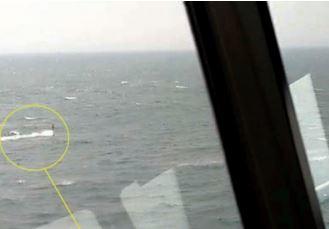202109 Close call with a submarine
As edited from MAIB (UK) report 13/2020
A fast ferry was underway at near 21 knots when the lookout saw a submarine periscope at close range on the port bow. He immediately alerted the OOW, who observed from the periscope’s wake that the submarine was crossing the ferry’s bow from port to starboard. Given this information, and assessing that there was an mminent risk of collision, the OOW told the lookout to take hand-steering and to apply 10° of port rudder. Further port rudder was put on shortly afterward to increase the closest point of approach (CPA) from the periscope. The OOW alerted the Master, who came to the bridge immediately. About 45 seconds later, with the submarine’s periscope passing close to starboard at about 6 knots, the ferry was brought to a steady heading.

Submarine periscope as seen from ferry
As it turned out, the submarine’s command team had made several errors that each contributed to the close quarters situation. The approach speed of the ferry was under-estimated (taken as 15 knots instead of 21) and the ferry’s range was overestimated. Both of these errors contributed to another critical error on the part the submarine’s command team to remain at periscope depth instead of deep diving out of harm’s way.

Lessons learned
- This close call illustrates the importance of keeping a sharp lookout. Had the ferry’s lookout not spotted the periscope, a high speed collision with the submarine was a distinct possibility.
- Turning to port to avoid a collision with another vessel on your port side is usually not the best choice of manoeuvres but given the speed of closure between the two vessels in this instance (27 kts), their respective positions and the good visibility, it proved to be the right one.
